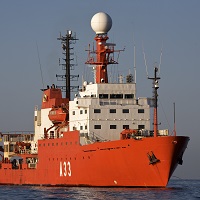Keyword
302
2 record(s)
Type of resources
Categories
Topics
INSPIRE themes
Keywords
Contact for the resource
Provided by
Years
Formats
Status
-
The cruise D361 forms part of a study entitled 'Physical and chemical forcing of diazotrophy in the (sub)-tropical Atlantic Ocean'. The study is investigating the potential influence of iron and phosphorus availability on nitrogen fixation in regions of the tropical Atlantic Ocean. The cruise also undertakes deep trace metal clean CTD casts as part of the International GEOTRACES programme. The purpose of the cruise therefore is to undertake measurements of dissolved and particulate iron and phosporpus availability, their spatial and temporal variations, and their impact on diazotrophy in the surface ocean. Aim: To quantify the supply and determine the biogeochemical cycling of Fe and other nutrients, and relate this to N2 fixation, diazotroph species distribution and N* fields. 1. Quantify the distribution of nutrients and trace metals: Quantify surface water and water column distributions of dissolved inorganic/organic N, P, Fe, and DAl, DMn and particulate P, N, Fe, Al, Mn. 2. Quantify the rate of Fe, Al, Mn, P and N supply to surface waters: Assess the source fluxes of the key elements for diazotrophs and source tracers to the surface ocean from atmospheric deposition and internal transport via diapycnal mixing and lateral advection. 3. Identify the source of subsurface Fe enrichment: Identify whether Fe-rich subsurface waters of the tropical North Atlantic thermocline originate from the atmosphere or the shelf using Fe distributions and Al, Mn, and O2 source tracers. 4. Quantify the diazotrophic response to Fe, phosphate, DOP supply: Relate the spatial distributions of inorganic Fe and organically complexed Fe, and phosphate and DOP to diazotrophy. The specific uptake of Fe, phosphate and DOP by the whole microbial community and Trichodesmium will be assessed by shipboard incubations, radiotracer techniques and enzyme bioassays. In addition, we will identify the connection between N2 fixation rates and diazotroph community structure, by comparing size fractionated 15N2-derived rates of N2 fixation (Fig. 1) with abundance and diversity of diazotrophs using nifH phylogeny. Objective 5: Investigate how the large scale transport pathways of Fe and P influence the N* distribution: Use fine-scale isopycnic model to reveal the large-scale transport pathways of Fe and P in the (S)-T Atlantic, and their effect on the N* distribution.
-

FICARAM cruise aims to investigate the evolution of decadal anthropogenic carbon and to evaluate the CO2 uptake capacity in the sector South Atlantic Ocean and its spread to Ecuador and Nord-tropical zone. The section of this cruise is a repeat section following the trace made in 1994 by IFREMER (Laboratoire de Physique des Oceans) into the French project CITHER as a WOCE (http://wwz.ifremer.fr/lpo/Moyens-a-la-mer/Les-campagnes-a-la-mer/Cither-2). This section was repeated in 2001 and 2002 by the Oceanology Group of the Instituto de Investigaciones Marinas of CSIC as part of CAVASSO and CARBOOCEAN European projects. This section is part of the international programs GOSHIP (http://www.go-ship.org/CruisePlans.html) and IOPCC. These programs allow the coordination between the various activities in the global ocean (http://www.go-ship.org/RefSecs/GOSHIPMap_April2011.pdf). The objectives of this cruise are framed in the EU FP7 project CARBOCHANGE (http://carbochange.b.uib.no/) under grant agreement nº 264879. Another important component of FICARAM cruise aims examine the biological and biogeochemical mechanisms that hinder total dissolved organic carbon (DOC) remineralisation in marine systems, taking a multidisciplinary perspective and applying many different approaches. This objective is the global objective of the Spanish project DOREMI that join this FICARAM cruise. Along the section, the DOREMI project will test the effect of different factors (carbon and nutrient additions, and microbial structure) on DOC degradation in epipelagic, mesopelagic and deep waters, developing some experiments determining the potential degradability of mesopelagic and epipelagic DOM, and the role that labile C supplements plays regulating this process and by the microbial structure.
 Catálogo de datos del IEO
Catálogo de datos del IEO